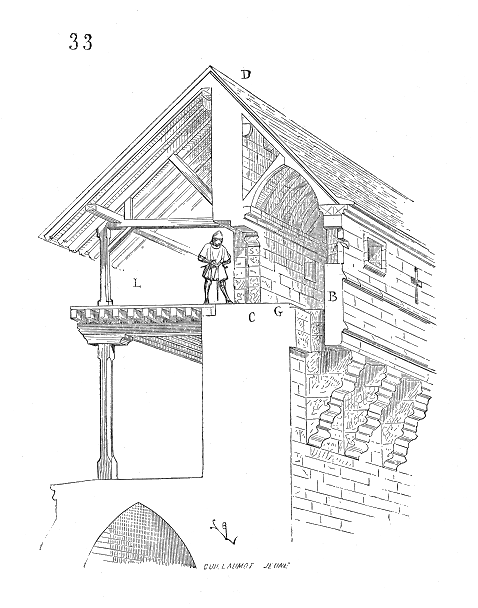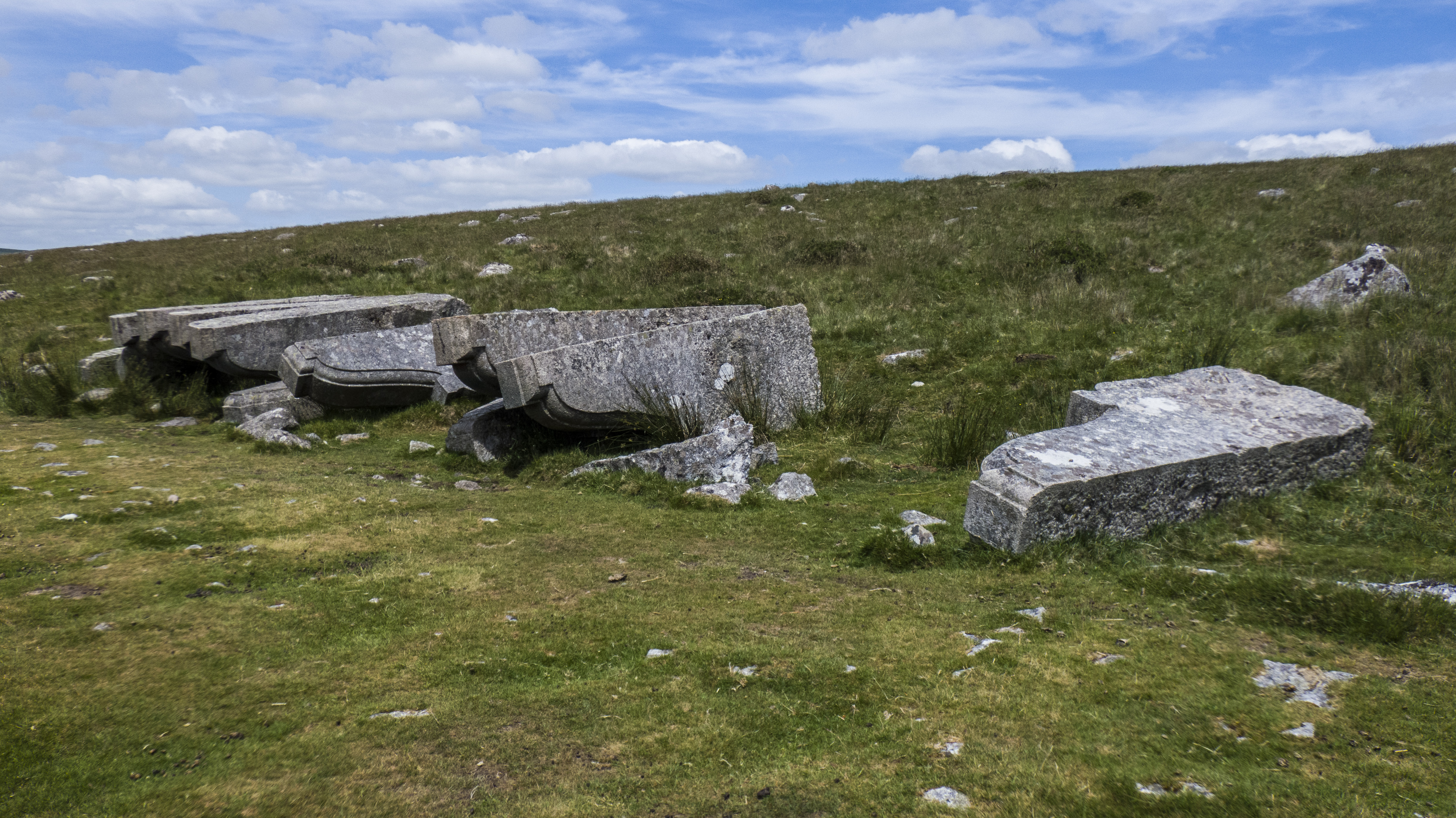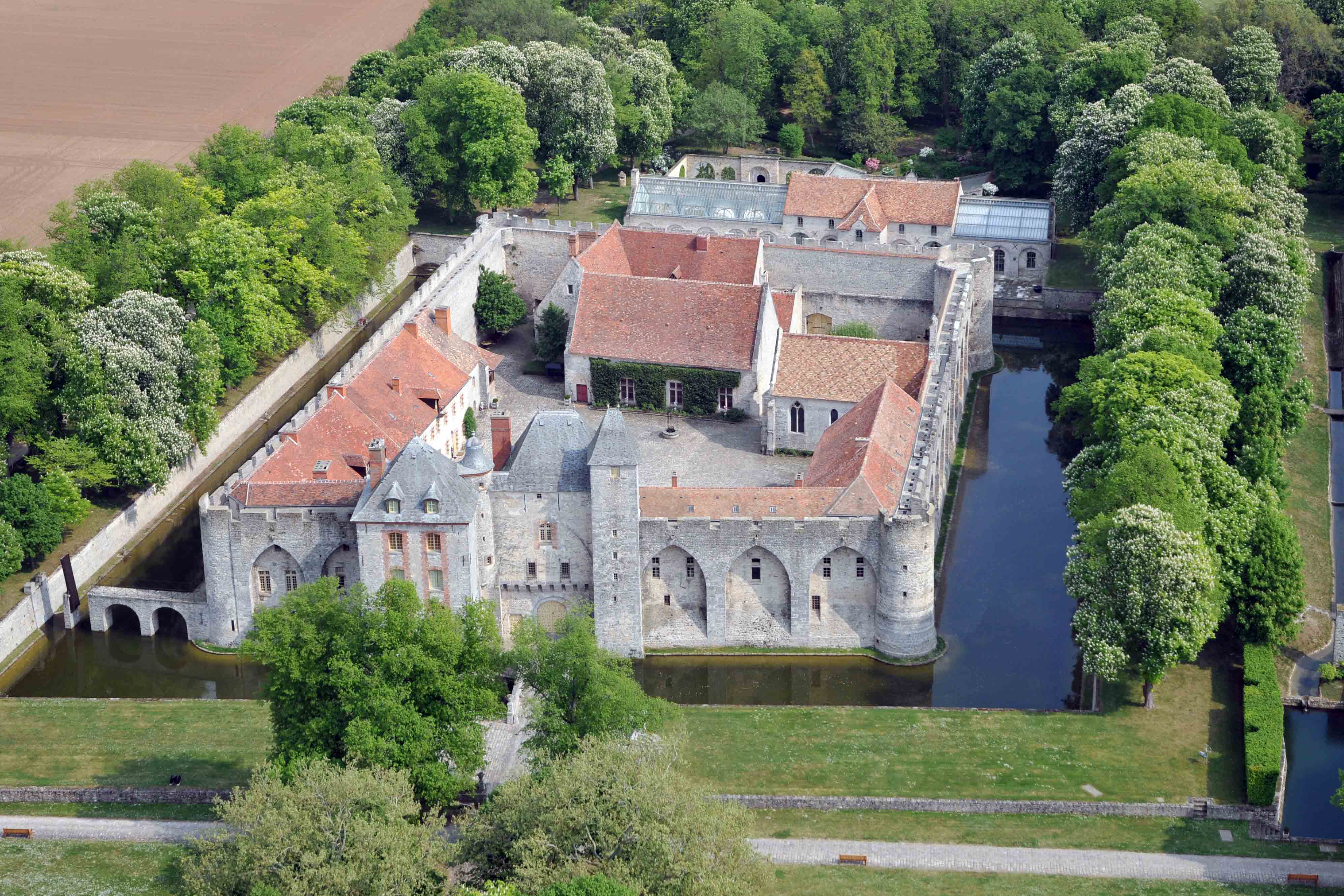|
Machicolations
In architecture, a machicolation () is an opening between the supporting corbels of a battlement through which defenders could target attackers who had reached the base of the defensive wall. A smaller related structure that only protects key points of a fortification are referred to as Bretèche. Machicolation, hoarding, bretèche, and murder holes are all similar defensive features serving the same purpose, that is to enable defenders atop a defensive structure to target attackers below. The primary benefit of the design allowed defenders to remain behind cover rather than being exposed when leaning over the parapet. They were common in defensive fortifications until the widespread adoption of gunpowder weapons made them obsolete. Etymology The word machicolation derives from Old French , mentioned in Medieval Latin">-4; we might wonder whether there's a point at which it's appropriate to talk of the beginnings of French, that is, when it wa ... , mentioned in Medieval Latin as ... [...More Info...] [...Related Items...] OR: [Wikipedia] [Google] [Baidu] |
Corbel
In architecture, a corbel is a structural piece of stone, wood or metal keyed into and projecting from a wall to carry a wikt:superincumbent, bearing weight, a type of bracket (architecture), bracket. A corbel is a solid piece of material in the wall, whereas a console is a piece applied to the structure. A piece of timber projecting in the same way was called a "tassel" or a "bragger" in England. The technique of corbelling, where rows of corbels deeply keyed inside a wall support a projecting wall or parapet, has been used since Neolithic (New Stone Age) times. It is common in medieval architecture and in the Scottish baronial style as well as in the vocabulary of classical architecture, such as the modillions of a Corinthian order, Corinthian cornice. The corbel arch and corbel vault use the technique systematically to make openings in walls and to form ceilings. These are found in the early architecture of most cultures, from Eurasia to Pre-Columbian architecture. A conso ... [...More Info...] [...Related Items...] OR: [Wikipedia] [Google] [Baidu] |
Murder Hole
A murder hole or meurtrière is a hole in the ceiling of a gateway or passageway in a fortification through which the defenders could shoot, throw or pour harmful substances or objects such as rocks, arrows, scalding water, hot sand, quicklime, or boiling oil, down on attackers. Boiling oil was rarely used because of its cost. Murder holes and machicolations Similar holes, called machicolations, were often located in the curtain walls of castles, fortified manor houses, and city walls. The parapet would project over corbels so that holes would be located over the exterior face of the wall, allowing the defenders to target attackers at the base of the wall. The primary difference between these two features is in their location. Murder holes were located on the interiors of castles and other fortified buildings at the entranceway. Their supposed intention was to discourage (or kill) invaders once they had breached the walls, though it has been suggested that they may have in so ... [...More Info...] [...Related Items...] OR: [Wikipedia] [Google] [Baidu] |
Château De Farcheville
The Château de Farcheville is a 14th-century castle in the '' commune'' of Bouville near Paris in the ''département'' of Essonne. The castle was built between 1290 and 1304, by Hughes II de Bouville and Hugues III, Lords of Farcheville and Bouville. The Château de Farcheville is a rare example of rural, open–filled castle of the medieval period. The great hall was built in 1291 and the castle chapel was consecrated in 1304. Both father and son were chamberlain to Philip IV of France. The structure possesses a rare northern French example of arched machicolations on buttresses, more characteristic of military architecture in the Languedoc. The castle passed to the family of Châtillon in the fifteenth century. In 1990 film producer Jean Chalopin, owner of the property from 1989 to 2006, began a project to restore the Château. The castle was once owned by Yellowstone Club founders Edra and Tim Blixseth. Following the Blixseth's 2009 divorce and bankruptcy, the castle ... [...More Info...] [...Related Items...] OR: [Wikipedia] [Google] [Baidu] |
Coupe
A coupe or coupé (, ) is a passenger car with a sloping or truncated rear roofline and typically with two doors. The term ''coupé'' was first applied to horse-drawn carriages for two passengers without rear-facing seats. It comes from the French past participle of , "cut". Some coupé cars only have two seats, while some also feature rear seats. However, these rear seats are usually lower quality and much smaller than those in the front. Furthermore, "A fixed-top two-door sports car would be best and most appropriately be termed a 'sports coupe' or 'sports coupé'". __TOC__ Etymology and pronunciation () is based on the past participle of the French verb ("to cut") and thus indicates a car which has been "cut" or made shorter than standard. It was first applied to horse-drawn carriages for two passengers without rear-facing seats. These or ("clipped carriages") were eventually clipped to .. There are two common pronunciations in English: * () – the anglicized ... [...More Info...] [...Related Items...] OR: [Wikipedia] [Google] [Baidu] |
Limes Arabicus
The ''Limes Arabicus'' was a desert frontier of the Roman Empire, running north from its start in the province of Arabia Petraea. It ran northeast from the Gulf of Aqaba for about at its greatest extent, reaching northern Syria and forming part of the wider Roman ''Limes (Roman Empire), limes'' system. It had several forts and watchtowers. The reason of this defensive ''limes'' was to protect the Roman province of Arabia from attacks of the nomadic tribes of the Arabian Peninsula, Arabian desert. The main purpose of the ''Limes Arabicus'' is disputed; it may have been used both to defend from Arab raids and to protect the commercial trade routes from robbers. Next to the ''Limes Arabicus'' Emperor Trajan built a major road, the Via Nova Traiana, from Bosra to Aqaba, Aila on the Red Sea, a distance of . Built between 111 and 114 AD, its primary purpose may have been to provide efficient transportation for troop movements and government officials as well as facilitating and prote ... [...More Info...] [...Related Items...] OR: [Wikipedia] [Google] [Baidu] |
Jettying
Jettying (jetty, jutty, from Old French ''getee, jette'') is a building technique used in medieval timber framing, timber-frame buildings in which an upper floor projects beyond the dimensions of the floor below. This has the advantage of increasing the available space in the building without obstructing the street. Jettied floors are also termed ''jetties''. In the U.S., the most common surviving colonial version of this is the garrison house. Most jetties are external, but some early medieval houses were built with internal jetties. Structure A jetty is an upper floor that depends on a cantilever system in which a horizontal beam, the jetty bressummer, supports the wall above and projects forward beyond the floor below (a technique also called ''oversailing''). The bressummer (or breastsummer) itself rests on the ends of a row of jetty beams or joists which are supported by jetty plates. Jetty joists in their turn were slotted sideways into the diagonal dragon beams at ... [...More Info...] [...Related Items...] OR: [Wikipedia] [Google] [Baidu] |
Garderobe
Garderobe is a historic term for a room in a medieval castle. The ''Oxford English Dictionary'' gives as its first meaning a store-room for valuables, but also acknowledges "by extension, a private room, a bed-chamber; also a privy". The word derives from the French , meaning "robes (or clothing) protector". Its most common use now is as a term for a castle toilet. Store room is the French word for " wardrobe", a lockable place where clothes and other items are stored. According to medieval architecture scholar Frank Bottomley, garderobes were "Properly, not a latrine or privy but a small room or large cupboard, usually adjoining the chamber edroomor solar iving roomand providing safe-keeping for valuable clothes and other possessions of price: cloth, jewels, spices, plate and money." Toilet The term ''garderobe'' is also used to refer to a medieval or Renaissance toilet or a close stool. In a medieval castle, a garderobe was usually a simple hole discharging to the outsid ... [...More Info...] [...Related Items...] OR: [Wikipedia] [Google] [Baidu] |
Defensive Walls
A defensive wall is a fortification usually used to protect a city, town or other settlement from potential aggressors. The walls can range from simple palisades or earthworks to extensive military fortifications such as curtain walls with towers, bastions and gates for access to the city. From ancient to modern times, they were used to enclose settlements. Generally, these are referred to as city walls or town walls, although there were also walls, such as the Great Wall of China, Walls of Benin, Hadrian's Wall, Anastasian Wall, and the Atlantic Wall, which extended far beyond the borders of a city and were used to enclose regions or mark territorial boundaries. In mountainous terrain, defensive walls such as '' letzis'' were used in combination with castles to seal valleys from potential attack. Beyond their defensive utility, many walls also had important symbolic functions representing the status and independence of the communities they embraced. Existing ancient walls are ... [...More Info...] [...Related Items...] OR: [Wikipedia] [Google] [Baidu] |
Arrow Slit
An arrowslit (often also referred to as an arrow loop, loophole or loop hole, and sometimes a balistraria) is a narrow vertical aperture in a fortification through which an archer can launch arrows or a crossbowman can launch bolts. The interior walls behind an arrow loop are often cut away at an oblique angle so that the archer has a wide field of view and field of fire. Arrow slits come in a variety of forms. A common one is the cross, accommodating the use of both the longbow and the crossbow. The narrow vertical aperture permits the archer large degrees of freedom to vary the elevation and direction of their bowshot but makes it difficult for attackers to harm the archer since there is only a small target at which to aim. Balistraria, plural ''balistrariae'' (from balister, crossbowman), can often be found in the curtain walls of medieval battlements beneath the crenellations. History The invention of the arrowslit is attributed to Archimedes during the siege of Syracus ... [...More Info...] [...Related Items...] OR: [Wikipedia] [Google] [Baidu] |
Conwy Castle
Conwy Castle (; ) is a fortification in Conwy, located in North Wales. It was built by Edward I of England, Edward I, during his Conquest of Wales by Edward I, conquest of Wales, between 1283 and 1287. Constructed as part of a wider project to create the Conwy town walls, walled town of Conwy, the combined defences cost around £15,000, a massive sum for the period. Over the next few centuries, the castle played an important part in several wars. It withstood Welsh rebellions against English rule, the siege of Madog ap Llywelyn in the winter of 1294–95, acted as a temporary haven for Richard II of England, Richard II in 1399 and was held for several months by forces loyal to Owain Glyndŵr in 1401. Following the outbreak of the English Civil War in 1642, the castle was held by forces loyal to Charles I of England, Charles I, holding out until 1646 when it surrendered to the Roundheads, Parliamentary armies. In the aftermath, the castle was partially slighted by Parliament to ... [...More Info...] [...Related Items...] OR: [Wikipedia] [Google] [Baidu] |
Crusades
The Crusades were a series of religious wars initiated, supported, and at times directed by the Papacy during the Middle Ages. The most prominent of these were the campaigns to the Holy Land aimed at reclaiming Jerusalem and its surrounding territories from Muslim rule. Beginning with the First Crusade, which culminated in the Siege of Jerusalem (1099), capture of Jerusalem in 1099, these expeditions spanned centuries and became a central aspect of European political, religious, and military history. In 1095, after a Byzantine request for aid,Helen J. Nicholson, ''The Crusades'', (Greenwood Publishing, 2004), 6. Pope Urban II proclaimed the first expedition at the Council of Clermont. He encouraged military support for List of Byzantine emperors, Byzantine emperor Alexios I Komnenos, AlexiosI Komnenos and called for an armed pilgrimage to Jerusalem. Across all social strata in Western Europe, there was an enthusiastic response. Participants came from all over Europe and had a ... [...More Info...] [...Related Items...] OR: [Wikipedia] [Google] [Baidu] |









